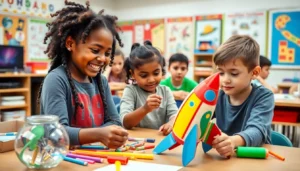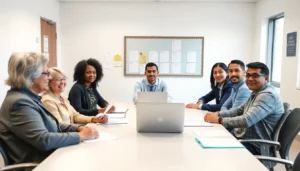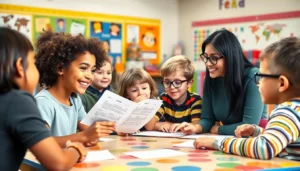Table of Contents
ToggleIn a world where traditional classrooms often feel like a one-size-fits-all sweater—itchy and uncomfortable—alternative education programs are stepping in like a stylish new jacket. These innovative approaches to learning offer a refreshing break from the mundane, catering to diverse learning styles and needs. Whether it’s through hands-on experiences, personalized curriculums, or a focus on real-world skills, alternative education is redefining what it means to be educated.
Overview of Alternative Education Programs
Alternative education programs present innovative solutions that address the gaps found in traditional classrooms. These programs cater to varying learning styles, emphasizing student engagement and personal growth.
Definition and Purpose
Alternative education refers to non-traditional learning environments that often stray from conventional school settings. These programs aim to meet individual student needs while fostering a supportive community. They prioritize personalized learning paths, allowing students to explore subjects at their own pace. The focus on holistic development prepares students for real-world challenges, enhances their skills, and promotes critical thinking. By providing flexibility and hands-on experiences, alternative education programs empower students to take ownership of their learning journeys.
Types of Alternative Education Programs
Various types of alternative education programs exist to accommodate unique educational needs. Montessori schools emphasize self-directed activity, allowing children to learn through exploration. Waldorf schools emphasize creativity, integrating arts and humanities into the curriculum. Another option includes online or hybrid programs, offering digital learning alongside in-person interactions. Charter schools provide choices with specific educational philosophies, often aiming for innovative teaching methods. Finally, experiential programs, such as project-based learning, encourage collaboration and practical application of knowledge. These diverse options enable students to find approaches that resonate with their individual learning preferences.
Benefits of Alternative Education Programs
Alternative education programs provide several advantages that enhance student learning and engagement. They focus on integrating various methods to create meaningful educational experiences.
Customized Learning Experience
Customized learning experiences emerge as a core benefit of alternative education programs. These programs tailor curriculums to individual student strengths, interests, and pace. Students gain opportunities to explore topics deeply rather than through a standardized approach. In a Montessori setting, for example, learners often choose materials and activities aligned with their interests, fostering autonomy. Programs that emphasize project-based learning allow students to engage in real-world applications, making education relevant. Flexibility within these programs enhances students’ motivation, resulting in a more significant investment in their education.
Support for Diverse Learning Needs
Support for diverse learning needs stands out as a key component in alternative education programs. Students with varying learning styles, abilities, and backgrounds thrive in environments that respect and embrace their differences. Alternative education encourages collaboration among peers, fostering social skills development. Many programs, such as Waldorf, integrate arts and practical skills, catering to diverse learners. With smaller class sizes, instructors can provide more personalized attention, ensuring students receive necessary support. Tailored assessments further measure individual progress, enhancing their educational experience and resulting in improved outcomes.
Challenges Faced by Alternative Education Programs
Alternative education programs encounter several challenges that can interfere with their effectiveness. Funding and resources often create obstacles, as many programs rely on limited budgets.
Funding and Resources
Funding challenges persist in alternative education programs, restricting their ability to provide necessary resources. Many programs operate with financial constraints that limit staff hiring, training, and resource allocation. Grants and donations play crucial roles in sustaining operations. Unfortunately, not all programs secure sufficient funding, affecting program availability and quality. Additionally, disparities in funding between traditional and alternative education programs can lead to inequitable access for students. When resources are scarce, programs struggle to maintain effective curriculums and supportive environments tailored to individual needs.
Public Perception and Stigma
Public perception negatively impacts alternative education programs. Many people view these programs as less credible than traditional education. Stigmas surrounding alternative education often arise from misconceptions about their effectiveness and structure. Families may hesitate to enroll their children due to fears of social stigma or concerns about college readiness. Additionally, educational authorities frequently face skepticism regarding the validity of alternative methods. Misunderstandings about alternative programs can hinder their growth and acceptance, limiting their potential to reach more students in need of innovative education solutions.
Successful Examples of Alternative Education Programs
Alternative education programs showcase innovative strategies that cater to diverse learning needs. They engage students through various methodologies, ensuring a tailored educational experience.
Case Study: Montessori Schools
Montessori schools emphasize self-directed learning within a structured environment. Students choose from a variety of activities that promote exploration and critical thinking. These schools prioritize individualized lesson plans, allowing learners to progress at their own pace. Research indicates that Montessori students often score higher on standardized tests compared to traditional counterparts. Parents appreciate the focus on holistic development, which nurtures independence and collaboration among peers. Additionally, the multi-age classroom setup fosters mentorship opportunities, enhancing social skills across different age groups.
Case Study: Charter Schools
Charter schools operate with greater flexibility than traditional public schools. They focus on innovative curriculums that often include specific themes such as the arts, sciences, or technology. Accountability is critical; charter schools must meet performance goals to maintain their funding. Many charter schools boast smaller class sizes, which promote personalized attention and richer student-teacher interactions. Programs also often include community involvement, connecting students with local resources and mentors. Data reveal that charter school students frequently demonstrate improved academic performance and higher graduation rates than those in conventional schools. These factors make charter schools an appealing alternative for many families seeking tailored educational options.
Alternative education programs represent a significant shift in how education can be approached. By prioritizing personalized learning and fostering supportive environments, these programs cater to the unique needs of each student. They not only enhance engagement but also empower learners to take control of their educational journeys.
While challenges remain in terms of funding and public perception, the success stories of various alternative education models demonstrate their potential to transform lives. As awareness grows and misconceptions are addressed, more students may benefit from these innovative educational solutions. Embracing alternative education is a step toward a more inclusive and effective learning landscape for all.






